My Japanese Apartment
by SealWyf, HSM editor
Home has two Japanese developers, Granzella and O-Two. Granzella is the heir to the vanished Irem, and one of O-Two’s labels is Peakvox, which has brought us the Peakvox Labs and Peakvox Ninja public spaces. I suspect these developers are working primarily for the JP Home market, but as long as they have the goods, they might as well sell them to other markets as well. And so we get some startlingly exotic content here in North America.
Many of O-Two’s and Granzella’s products are generic, and easily translatable. But some quintessentially Japanese items are being dropped into NA Home with little or no explanation. It’s up to us to decide what to make of them. Some of these items will be familiar to fans of Japanese animation. School uniforms and stereotypical anime characters and emotes are easily comprehended. But other items depend on a deeper knowledge of Japanese culture, the kind you pick up by taking some Japanese language classes. If we “get it”, all well and good. If we don’t, it doesn’t matter. The developers won’t go out of their way to enlighten us.
Granzella has released items that tie in with specific Japanese holidays and celebrations. Last New Year’s Day, the Grand Edo space was redecorated to feature hawks and giant eggplants floating in front of the distant Mount Fuji. This refers to hatsuyume, the Japanese tradition that the first dream you have in the new year is important. And the most auspicious things you can dream about are Mount Fuji, hawks and eggplants. Why? Apparently nobody is sure. But any Japanese viewing the space would have understood the reference, while we gaijin were honestly puzzled.
In March, Granzella released a display rack of dolls for Girls’ Day (Hinamatsuri), and in April, they released wind-sock carp items for Children’s Day (Kodomo no Hi). Cherry blossom season (hanami) was recognized with the picnic blanket “locomotions” — picnics and drinking parties under the flowering trees is a Japanese tradition. And of course there is the Tea Garden apartment, with its built-in tea ceremony mini-game and seasonal changes. Until recently, if you wanted to create a Japanese lifestyle in Home, you were pretty much limited to Granzella.
However, O-Two has now entered the NA Home area with their Peakvox game spaces and other content. Their most recent production is an apartment with seasonal changes — something we have been requesting for a very long time. The seasonal aspect is nice, but it’s not as immersive as it might have been in a primarily outdoor space such as the Tea Garden apartment.
But what I find especially exciting about this space is that it is an authentic Japanese urban apartment, complete with tatami room. No explanation is provided — you are assumed to know what you are looking at. And the tatami room has puzzled more than a few American purchasers.
So, as a public service to NA Home users, I would like to point out the quintessentially Japanese features of this new personal space, and give some tips for decoration.
The entryway (genkan):
You’ll notice some cabinets to the right, as you spawn inside the front door. Those aren’t just generic storage space. They are a place to put your street shoes. Japanese — even urban, Westernized Japanese — think that wearing street shoes in the house is disgusting and unsanitary. You might want to dress your avatar accordingly.
The bedroom:
Using a western style bed here is okay, but if you want to go fully Japanese you will want to acquire one of the Granzella folded futons. In America, we use the term “futon” for a couch that unfolds into a bed. But, properly speaking, a futon is a thin mattress that can be folded up during the day to save floor space. At night it is spread out, and the sleeper is covered with a quilt.
In a real Japanese house, the futon would probably be stored in the large closet to the left as you enter the bedroom. We don’t have that luxury, so I put a large rug in the room and set the folded futon on one end of it. The rest of the decoration was provided by the Japanese style chests of drawers (tansu) we have received from Sony and other Japanese developers. I also added the “Cats Hard at Work” Minco doll from the much-missed Irem Square. In my fantasy, this apartment is owned by a young Japanese woman who loves both the traditional and kawaii sides of Japanese culture, as well as Western-style luxuries, such as expensive Sony electronics.
The bathrooms (yokushitsu and senmenshitsu):
You’ll notice that the bathroom is divided into three sections. The first door you reach on your left leads to a room with a sink, and a second room with a bathtub. It’s a Western-style tub, and I was frankly disappointed we didn’t get a Japanese style soaking tub (which resembles a small hot tub) with an area for scrubbing down with soap outside the tub. But the scrubbing area is implied by the shower-head on the flexible hose next to the sink in the bathtub room, so I added a wooden platform, and the bathing chair and bucket from Granzella’s “City of Flowers” apartment.
I am puzzled by the raised tile platform with the drain in the sink room. If anyone can explain this in the comments, I would appreciate it. My only theory is that it is the base for a very small shower stall. Perhaps O-Two will provide the stall itself in the future.
The next door down the hall opens into the room for the toilet (senmenshitsu). Separating the toilet from the washing and bathing area is very Japanese, and indeed was not uncommon in European and some older American houses as well. Any of the western-style toilet chair items can be used here. And if we ever get a Japanese style toilet in NA Home, you could use that here instead. At least our male avatars already have the proper squatting pose.
The kitchen:
The tiny kitchen is very realistic for a Japanese urban apartment. Apartments in Japan are quite compact. This one is actually fairly spacious, judging from the floorplans for urban apartments on the Internet.
However, Home furnishings tend to be scaled for large spaces, and none of the recent kitchen offerings really fit. I finally settled on a combination of the Ghostbusters stove, dishwasher, sink and counter, one of the small SMUG refrigerators from VEEMEE, and a counter unit from MIB which, though not really designed for a kitchen, fit the remaining space very nicely. I hope O-Two provides some kitchen furnishings scaled for this space. Using the Ghostbusters items was definitely a “make-do”, and I’m not really happy about it.
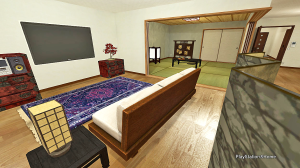
The living area; the dining area is offscreen to the right. The tatami room can be seen to the rear.
The living room:
This large combined space can be divided into a dining area and a seating area with an entertainment center. The centered picture space on the right hand wall works well for a wall-mounted LOOT EOD TV, and if you are careful you will have enough slots left for a LOOT Radio as well.
From what I have seen in movies and on the Internet, most urban Japanese divide their living spaces into Western and traditional Japanese sections, with Western-style couches and electronics in the main living room, and Japanese furnishing in the tatami room. This is the strategy I used here, although I did include some Japanese furnishings in the main room, such as the folding screen that divides the two areas. It’s a lovely screen (O-Two sells a number of them), and I wanted to use it somewhere. The Zen couch from Bigyama works very well here as well.
The tatami room:
This room is what makes this space a quintessentially Japanese apartment. The Japanese people have a great affection and nostalgia for their older, more rural culture. Many have had to move into Western-style apartments since the War. But, whenever possible, they will set aside part of the space for a traditional Japanese room with tatami mat flooring.
No Western furniture is used in this room. If the apartment owner is a student of the tea ceremony (chanoyu), this is performed here. It is also a gracious place to relax in traditional Japanese garb, such as the yukata.
Decorate your tatami room with simple Japanese furniture and decorations. This is a case where “less is more” — a simple wall scroll and a bonsai tree or an ikebana display are all the ornaments you need.
The balcony view:
Here you can see the complex merger of urban space with nature that haunts much of Japanese culture. Apartment blocks partly screen a distant park with a grove of cherry trees. They are in full bloom in the spring version. The winter scenery is especially evocative, with gently falling snow. The summer is intense, and you feel the overwhelming heat radiating from the dark blue sky. Autumn is a sunset, with the sky aflame with orange.
You can set the season manually, from a control panel next to the glass doors, or let the apartment cycle naturally through the seasons to match the external world. The seasonal changes affect more than the view. The color and intensity of light changes throughout the apartment. Change the season, and revisit each room to see how the atmosphere has changed. This place is a lot more subtle than it first appears.
Why was it important to add the seasons, and to take the trouble to change the light color in every room, an effect that most people won’t even notice? And why was O-Two the first developer to pull this off?
I think it’s because they are Japanese. Since Japan was mostly rural until the past few decades, the people there are still acutely aware of the passing seasons. Many of their traditional holidays and festivals are tied to the seasonal cycle and the world of nature.
Most Japanese now live in city apartments much like this new private space. But the vanished world of rural Japan can still be seen in media, such as the animated films of Hayao Miyazaki. Seasonal and nature images are an integral part of traditional Japanese poetic forms, such as the haiku. The view from the balcony, and the changing seasonal interior light, are this apartment’s way of acknowledging the natural world outside. And I love it that it can be left to cycle naturally, though without the subtle transitions of the real world.
Even as a gaijin with only a small knowledge of Japanese language and culture, I appreciate the thought and aesthetic feeling that went into designing this apartment. I am delighted that Home has become an international platform, with developers sharing content freely among regions. It makes me feel like I’m part of something large and culturally complex. And I look forward to seeing what we get next.
Share
| Tweet |


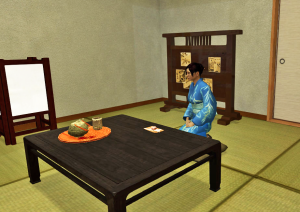
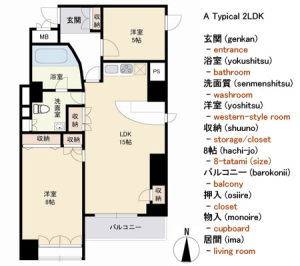
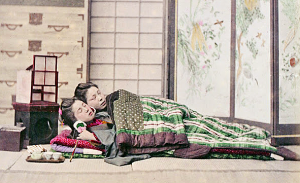
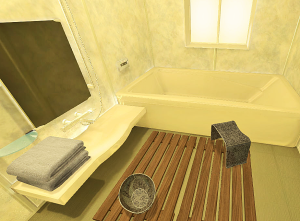
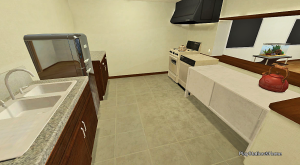


That’s for the washing machine. Japanese houses and apartments usually place them in the sink room (with some exceptions).
Here’s a example from a real estate page.
http://www.hituji.jp/comret/info/tokyo/taito/nature-plus-one/images/023
Thank you! That makes sense. Now I will have to look for an itty bitty washing machine.
Great article, especially for us Japanophiles! Beyond what these developers are offering in terms of different cultural realms, I have to say that this is how Sony differentiates itself from the competition. They as a company respect all cultures, and are focused on creating as much exposure as possible.
I agree it can be risky for developers to offer items distinctive to certain cultures, but I believe consumers are a lot more open than they seem. I also have to add that it shows how much respect these developers have that they are comfortable offering items fully immersed with cultural significance. I will definitely take a look at the apartment and look forward to a hopeful influx of Japanese furniture items in the future. Yay!